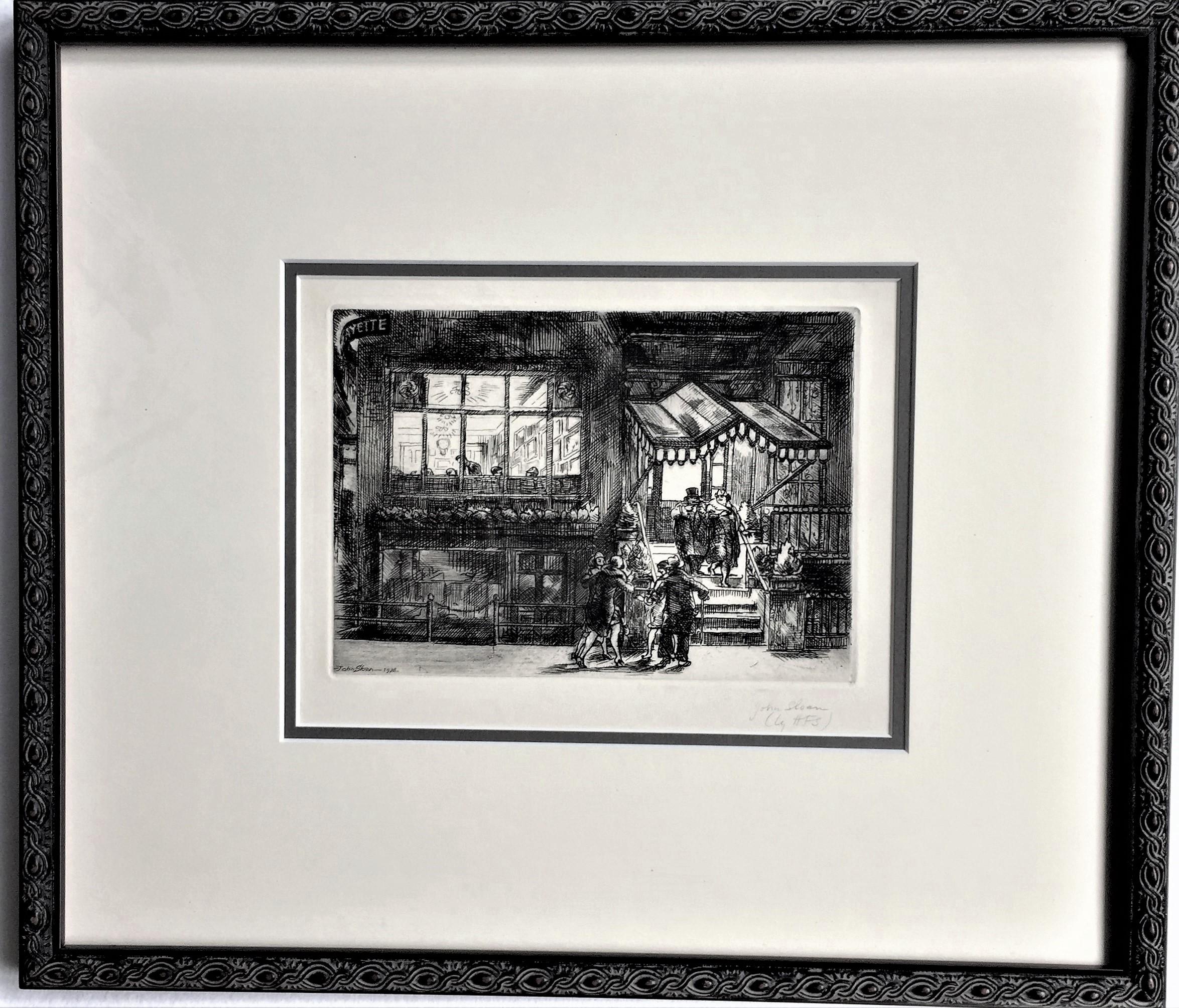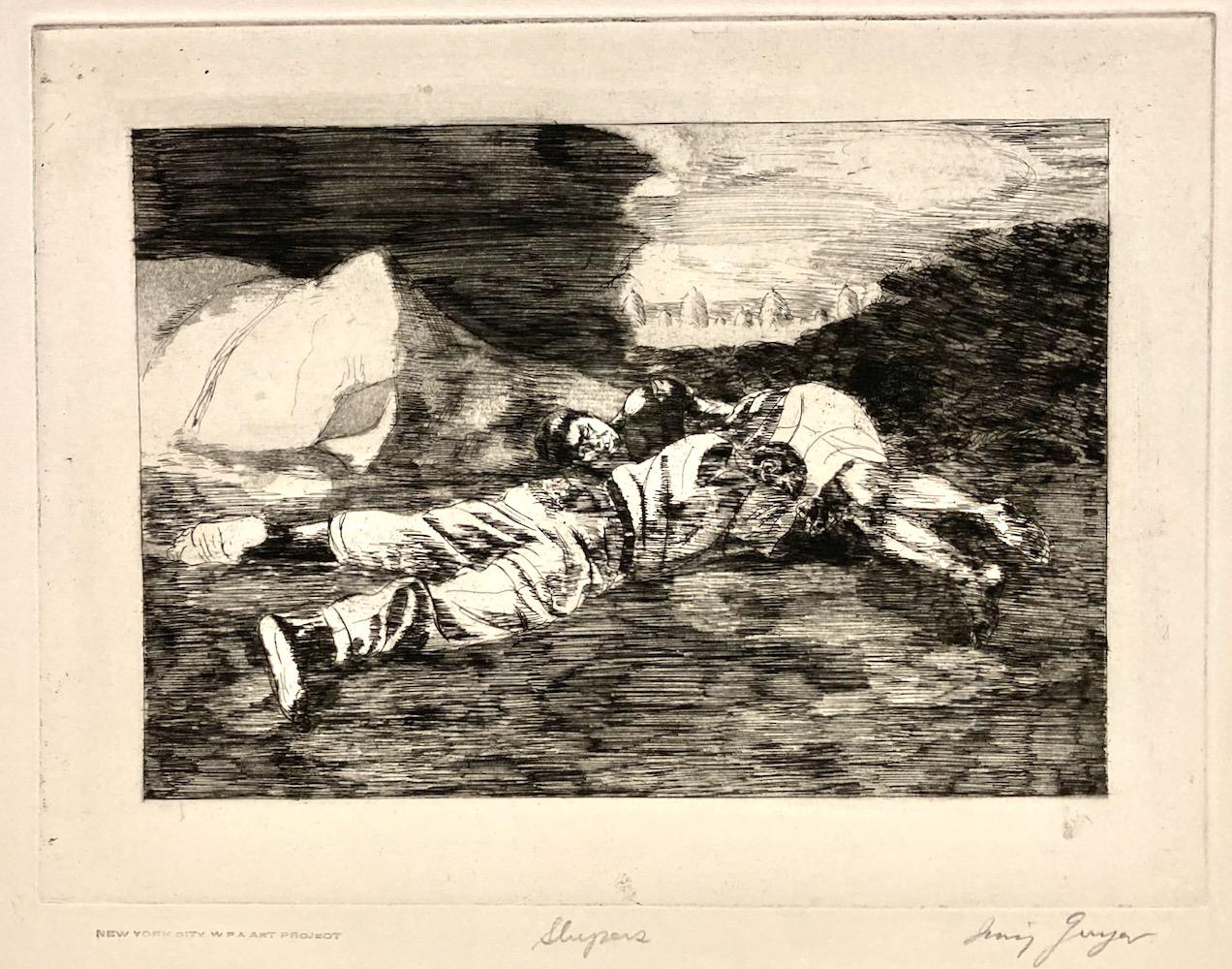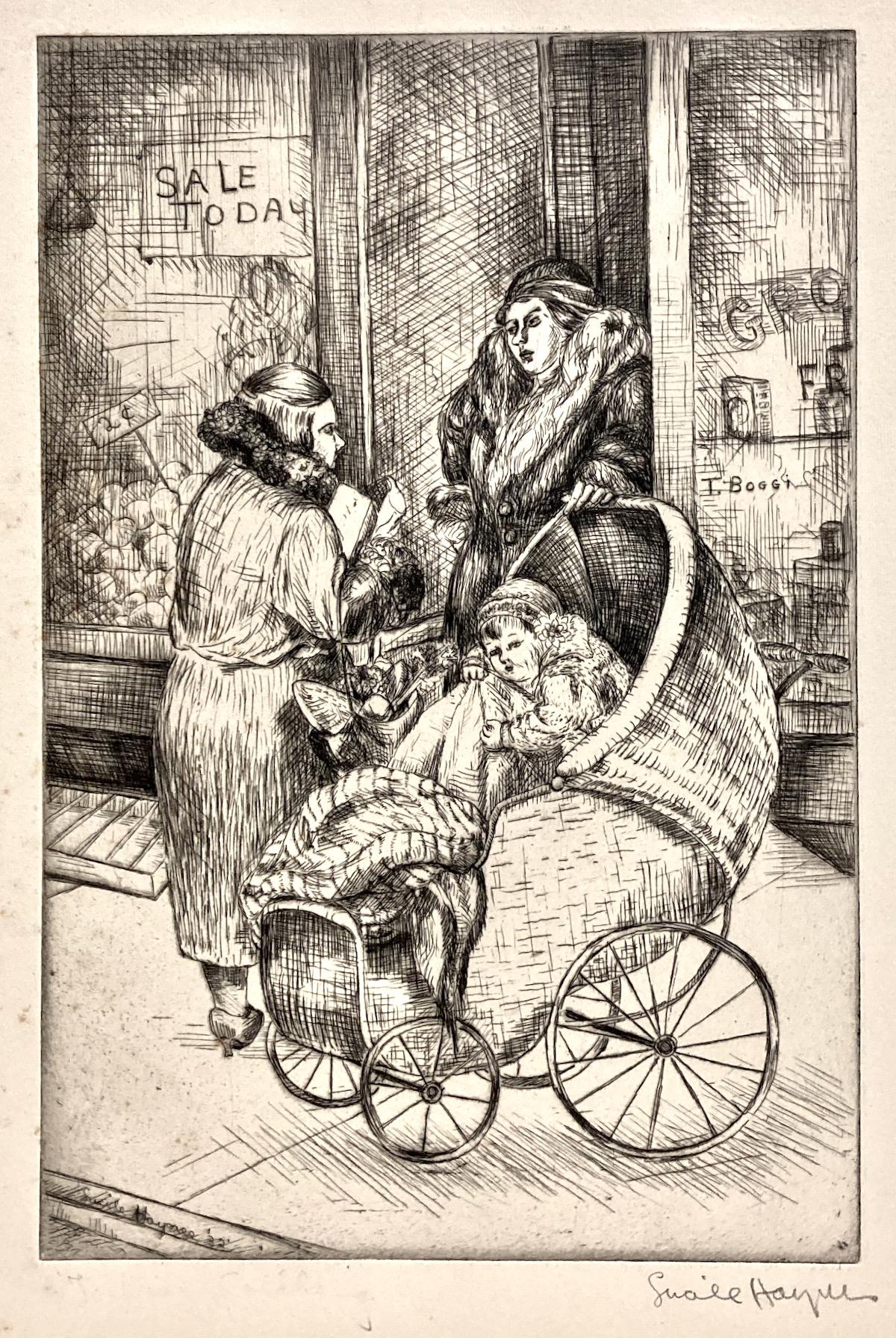Items Similar to Boys Sledding
Want more images or videos?
Request additional images or videos from the seller
1 of 7
John SloanBoys Sledding1920
1920
About the Item
Boys Sledding
Etching, 1920
Signed and titled in pencil by the artist below image (see photos)
Annotated in pencil by the artist "100 proofs"
Signed and dated in the plate lower left corner (see photo)
Edition: Intended edition: 100, this being one of 50 impressions actually printed
Condition: Excellent
Image/Plate size: 5 3/8 x 7 1/8 inches
Provenance:
Kennedy Galleries, New York
Mrs. George A. Martin (until 1949)
Baldwin-Wallace College, Berea, OH (49.613; 1949-2010)
Sloan probably printed the 30 "early" impressions, this being one.
Reference:
Peter Morse, John Sloan's Prints: A Catalogue Raisonne of the Etchings, Lithographs, and Posters (New Haven and London: Yale University Press, 1969), 197 iii/III
Boys playing after a snow storm in Washington Park, Manhattan
- Creator:John Sloan (1832-1932, American)
- Creation Year:1920
- Dimensions:Height: 5.375 in (13.66 cm)Width: 7.125 in (18.1 cm)
- Medium:
- Movement & Style:
- Period:
- Condition:A very rich impression in excellent condition.
- Gallery Location:Fairlawn, OH
- Reference Number:
John Sloan
John Sloancame to New York in 1904 and worked for some time as a freelance illustrator. With Robert Henri, he organized an exhibition of a group of urban realist painters, known as "The Eight" or the "Ashcan School," who challenged traditional notions of art. Having moved to the Village in 1912, Sloan lived with his wife Dolly at 240 West 4th Street and at 88 Washington Place.
About the Seller
5.0
Recognized Seller
These prestigious sellers are industry leaders and represent the highest echelon for item quality and design.
Platinum Seller
These expertly vetted sellers are 1stDibs' most experienced sellers and are rated highest by our customers.
Established in 1978
1stDibs seller since 2013
712 sales on 1stDibs
Typical response time: 1 hour
Associations
International Fine Print Dealers Association
- ShippingRetrieving quote...Ships From: Fairlawn , OH
- Return PolicyA return for this item may be initiated within 10 days of delivery.
More From This SellerView All
- Irving Place BurleskBy Reginald MarshLocated in Fairlawn, OHIrving Place Burlesque Etching, 1930 Unsigned (as usual for the Whitney edition) Numbered in pencil lower left Blind stamp of the Whitney Museum (WM) lower right From: Reginald Marsh...Category
1930s Ashcan School Figurative Prints
MaterialsEtching
- Emma and Marjorie on a SofaBy George Wesley BellowsLocated in Fairlawn, OHEmma and Marjorie on a Sofa Lithograph printed on chine paper, 1921 Signed by the artist lower right (see photo) Signed by the printer Bolton Brown lower left (see photo) Edition: 44...Category
1920s Ashcan School Figurative Prints
MaterialsLithograph
- The Irish FairBy George Wesley BellowsLocated in Fairlawn, OHIrish Fair Lithograph, 1923 Signed and numbered in pencil by the artist (see photo) Titled "Irish Fair" by the artist in pencil Edition: 84 Housed in an archival frame with acid free...Category
1920s Ashcan School Figurative Prints
MaterialsLithograph
- L'Aieule (The Grandmother)By Louis LegrandLocated in Fairlawn, OHL'Aieule (The Grandmother) Etching and aquatint printed in colors, 1904 Signed with the red stamp of the publisher, Gustave Pellet, Lugt 1193 and numbered (see photo) Edition: 100 (81/100) Reference: Arwas 202 iv/IV IFF 98 Condition: Excellent, the sheet aged as usual Image size: 14 1/4 x 18 5/8" Sheet size: 16 15/16 x 24 1/4" Louis Auguste Mathieu Legrand (29 September 1863 – 1951) was a French artist, known especially for his aquatint engravings, which were sometimes erotic. He was awarded the Légion d'honneur for his work in 1906. Life Legrand was born in the city of Dijon in the east of France. He worked as a bank clerk before deciding to study art part-time at Dijon's Ecole des Beaux-Arts. He won the Devosge prize at the school in 1883.[2] In 1884 Legrand studied engraving under the Belgian printmaker Félicien Rops. Legrand's artworks include etchings, graphic art and paintings. His paintings featured Parisian social life. Many were of prostitutes, dancers and bar scenes, which featured a sense of eroticism. According to the Hope Gallery, "Louis Legrand is simply one of France's finest early twentieth century masters of etching." His black and white etchings especially provide a sense of decadence; they have been compared to those of Henri de Toulouse-Lautrec, though his drawings of the Moulin Rouge, the can-can dance and the young women of Montmartre preceded Toulouse-Lautrec's paintings of similar scenes. He made over three hundred prints of the night life of Paris. They demonstrate "his remarkable powers of observation and are executed with great skill, delicacy, and an ironic sense of humor that pervades them all." Two of his satirical artworks caused him to be tried for obscenity. The first, "Prostitution" was a symbolic drawing which depicted a naked girl being grasped by a dark monster which had the face of an old woman and claws on its hands; the second, "Naturalism", showed the French novelist Émile Zola minutely studying the thighs of a woman with a magnifying glass. Defended by his friend the lawyer Eugène Rodrigues-Henriques (1853–1928), he was found not guilty in the lower court, but was convicted in the appeal court and then given a short prison sentence for refusing to pay his fine. Legrand was made famous by his colour illustrations for Gil Blas magazine's coverage of the can-can, with text by Rodrigues (who wrote under the pseudonym Erastene Ramiro). It was a tremendous success, with the exceptional quantity of 60,000 copies of the magazine being printed and instantly sold out in 1891. In 1892, at the instigation of the publishing house Dentu, Legrand made a set of etchings of his Gil Blas illustrations. The etchings were published in a book, Le Cours de Danse Fin de Siecle (The End of the Century Dance Classes). Legrand took a holiday in Brittany, which inspired him to engrave a set of fourteen lithographs of simple country life called Au Cap de la Chevre (On Goat Promontory). It was published by Gustave Pellet who became a close friend of Legrand's. Pellet eventually published a total of 300 etchings by Legrand, who was his first artist; he also published Toulouse-Lautrec and Félicien Rops among others. He did not only work in graphics; he exhibited paintings at the Paris salon of the Société Nationale des Beaux-Arts starting in 1902. In 1906 he was made a chevalier of the Légion d'honneur. Legrand died in obscurity in 1951. A retrospective exhibition was held at the Félicien Rops museum in Namur, Belgium in 2006 to celebrate his graphic art. The art collector Victor Arwas published a catalogue raisonné for the occasion. Books illustrated de Maupassant, Guy: Cinq Contes Parisiens, 1905. Poe, Edgar Alan: Quinze Histoires d'Edgar Poe...Category
Early 1900s Art Nouveau Figurative Prints
MaterialsAquatint
- Danseuses s'habillant (Laurence adjusting her hair and Mignon adjusting clothesBy Louis LegrandLocated in Fairlawn, OHDanseuses s'habillant (Laurence adjusting her hair and Mignon adjusting hre clothes) Drypoint & aquatint, 1893 Signed in the plate (see photo) After the division of the plate into A. 81 (as here) and A. 82 Divant la glace Editon 100 printed on velin paper Issued by Pellet in the set, Les Petites du Ballet, Gustave Pellet editeur, 1893 (13 plates), second state (b) without remarque Reference: Arwas 81, top portion of the plate vii/VIII Plate/Image size: 6 x 8 7/16 inches Condition: excellent Louis Auguste Mathieu Legrand (29 September 1863 – 1951) was a French artist, known especially for his aquatint engravings, which were sometimes erotic. He was awarded the Légion d'honneur for his work in 1906. Life Legrand was born in the city of Dijon in the east of France. He worked as a bank clerk before deciding to study art part-time at Dijon's Ecole des Beaux-Arts. He won the Devosge prize at the school in 1883.[2] In 1884 Legrand studied engraving under the Belgian printmaker Félicien Rops. Legrand's artworks include etchings, graphic art and paintings. His paintings featured Parisian social life. Many were of prostitutes, dancers and bar scenes, which featured a sense of eroticism. According to the Hope Gallery, "Louis Legrand is simply one of France's finest early twentieth century masters of etching." His black and white etchings especially provide a sense of decadence; they have been compared to those of Henri de Toulouse-Lautrec, though his drawings of the Moulin Rouge, the can-can dance and the young women of Montmartre preceded Toulouse-Lautrec's paintings of similar scenes. He made over three hundred prints of the night life of Paris. They demonstrate "his remarkable powers of observation and are executed with great skill, delicacy, and an ironic sense of humor that pervades them all." Two of his satirical artworks caused him to be tried for obscenity. The first, "Prostitution" was a symbolic drawing which depicted a naked girl being grasped by a dark monster which had the face of an old woman and claws on its hands; the second, "Naturalism", showed the French novelist Émile Zola minutely studying the thighs of a woman with a magnifying glass. Defended by his friend the lawyer Eugène Rodrigues-Henriques (1853–1928), he was found not guilty in the lower court, but was convicted in the appeal court and then given a short prison sentence for refusing to pay his fine. Legrand was made famous by his colour illustrations for Gil Blas magazine's coverage of the can-can, with text by Rodrigues (who wrote under the pseudonym Erastene Ramiro). It was a tremendous success, with the exceptional quantity of 60,000 copies of the magazine being printed and instantly sold out in 1891. In 1892, at the instigation of the publishing house Dentu, Legrand made a set of etchings of his Gil Blas illustrations. The etchings were published in a book, Le Cours de Danse Fin de Siecle (The End of the Century Dance Classes). Legrand took a holiday in Brittany, which inspired him to engrave a set of fourteen lithographs of simple country life called Au Cap de la Chevre...Category
1890s Art Nouveau Figurative Prints
MaterialsAquatint
- TrioBy Georges RouaultLocated in Fairlawn, OHTrio Color aquatint, 1938 Edition 250 printed on Montval wove paper with Maillol watermark From: Les Fleurs de Mal III (12 color aquatints) Published by A...Category
1930s French School Figurative Prints
MaterialsAquatint
You May Also Like
- Alexander Kachinsky, Uptown, NYCLocated in New York, NYRussian-born and European-educated Alexander Kachinsky was a designer of stage sets (for the Ballet Russe), furniture, and commercial interiors. His prints are in the collection of t...Category
Mid-20th Century Ashcan School Landscape Prints
MaterialsEtching
- The Lafayette.By John French SloanLocated in Storrs, CTThe Lafayette. 1928. Etching. Morse 233/vi. 4 7/8 x 6 7/8 (sheet 8 1/8 x 9 3/8). Proof prior to the intended edition of 100, that was probably closer to 80. A rich impression on crea...Category
1920s Ashcan School Figurative Prints
MaterialsEtching
- 'A Morning in May' — 1930s Social Realism, New York CityBy Reginald MarshLocated in Myrtle Beach, SCReginald Marsh, 'A Morning in May', etching, 1936, edition 100 (Whitney, 1969), Sasowsky 169. Unsigned as published; numbered '89/100' in pencil. A superb, richly-inked impression, ...Category
1930s Ashcan School Figurative Prints
MaterialsEtching
- New Year’s Eve and AdamBy John SloanLocated in Myrtle Beach, SCJohn Sloan, 'New Year's Eve and Adam', etching, 1918, edition 100, (only 85 printed), Morse 190. Signed, titled and annotated '100 proofs' in pencil. Signed and dated in the plate, l...Category
1910s Ashcan School Figurative Prints
MaterialsEtching
- Irving Guyer, SleepersBy Irving GuyerLocated in New York, NYClassic American Depression-Era subject meets the French landscape? Clearly the Guyer was looking at both Jean-Francois Millet and Vincent Van Gogh, who together informed this image....Category
1930s Ashcan School Figurative Prints
MaterialsEtching
- Lucile Haynes, (Two Women with Child in Baby Carriage)Located in New York, NYIt's clear to me that that baby carriage is so beautifully drawn that it could be re-constructed from here if necessary. Without really knowing anything about Lucile Haynes I'm sure...Category
1930s Ashcan School Figurative Prints
MaterialsEtching
Recently Viewed
View AllMore Ways To Browse
George Washington Print
Etchings Manhattan
Lithograph Snow
John Sloan Prints
Snow Storm
George Washington Etching
John Sloan Etchings
John Sloan Etching
John Martin Etching
Peter Storm
Snow Sled
If It Would Be True
Food Print
Vintage War Posters Art Posters
Vintage French Poster Artists
Vintage Seekers
Antique Mats
Vintage Travel Italy






